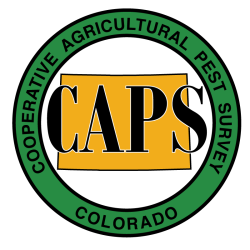Pest Survey
The Cooperative Agricultural Pest Survey (CAPS) is a national program involved in the early detection of, and rapid response to exotic pests that threaten Colorado's agriculture and environment. Activities include annual surveys for targeted pests, outreach, and education. Recent pests of concern include Emerald Ash Borer, Japanese Beetle, Spotted Lanternfly, Asian Longhorned Beetle, among many others. For a complete list of the most current pests and commodities being surveyed for, please see the 2023 Colorado CAPS Wanted Pests.
This program is a joint project with the United States Department of Agriculture (USDA) Plant Protection and Quarantine (PPQ), Colorado State University (CSU) and other state and federal groups. Please contact us for information concerning any of these or other exotic pests of concern or for any education or outreach needs.
Frequently Asked Questions
What does the CAPS program do?
- CAPS, which stands for Cooperative Agricultural Pest Survey, is funded by the federal government in almost every state to watch out for new invasive insects. The CAPS program is important because if we find a new invasive species in an at-risk area, we can stop the pest in its tracks before it becomes an established issue. Millions of dollars are saved every year by this program, because we prevent insects from causing damage before they become a huge problem.
- For example, imagine if the Old World Bollworm was on the loose in Colorado. This worm bores into the stems of fruits and vegetables, causing fruit to drop prematurely and significantly decreases overall crop yields. Millions of dollars would be spent on recovering crop damages, importing crops from other farmers, and on pesticides and biocontrol to try to control the Old World Bollworms. Because CAPS monitors for the Old World Bollworm, if a population of worms is discovered, we can wipe it out before they become established.
How do we decide which insects to look out for?
- Every state’s watchlist is different based on its climate. Because Colorado is dry, invasive species attracted to dry forest areas could potentially have a devastating effect on the environment.
- The CAPS program manager gets a list of all pests of concern from the federal government, and then does research on these insects to determine which ones might establish in their state. After they have a list of insects that could be harmful and could enter the state, they set up a plan to monitor and catch these insects before they become a problem.
How do we catch insects we are looking for?
- We use a variety of traps to catch the specific insects we are looking for. We also place chemical lures inside the traps that draw in the target species. The target species insect can smell these lures for miles, so if there is one in sight, we can catch it and trap it. The traps come equipped with kill strips so the insects within are caught, killed, and then shipped to a lab for identification.
What happens if we find a target insect?
- If we find a target insect we first alert the communities involved. Then, we continue monitoring and look for more of the target species to see if there is an established population on the rise in our target area. Finally, we isolate the insects to the area they are growing in and use APHIS sanctioned pesticides to stop the colony from establishing further.
Resources
Invasive Pests in Colorado
- Colorado CAPS Most Wanted Pests (2025)
- Spotted lanternfly (SLF)
- Asian Longhorned beetle (ALB)
- CSU Extension: Japanese Beetle Fact Sheet
Firewood publications
Previous Colorado CAPS Most Wanted Pests
